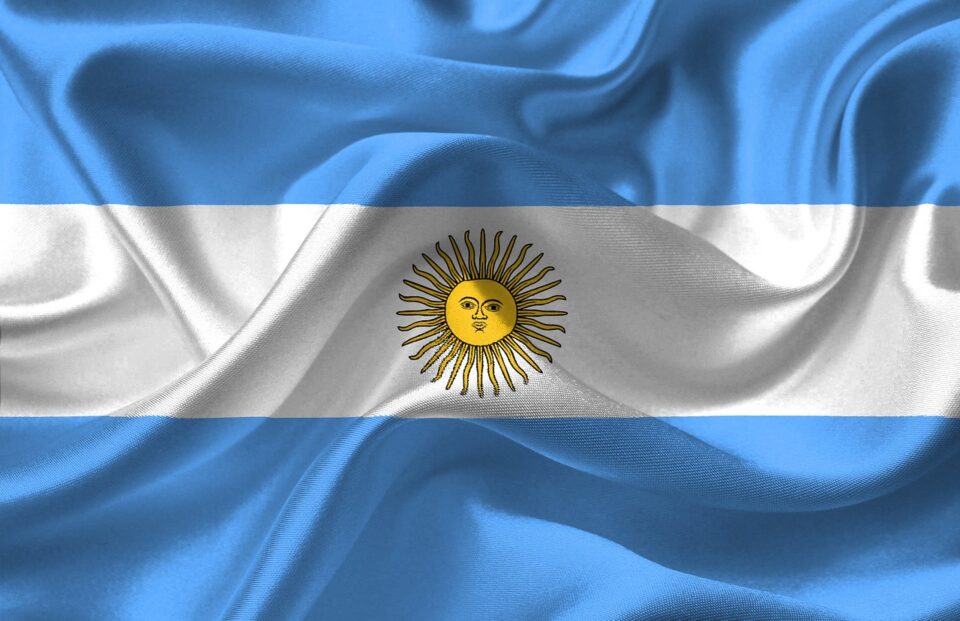
ARGENTINA
GEOGRAPHY
Argentina is shaped like an inverted triangle with its base at the top; it is some 880 miles (1,420 km) across at its widest from east to west and stretches 2,360 miles (3,800 km) from the subtropical north to the subantarctic south. The country is bounded by Chile to the south and west, Bolivia and Paraguay to the north, and Brazil, Uruguay, and the Atlantic Ocean to the east. Its undulating Atlantic coastline stretches some 2,900 miles (4,700 km). Argentina’s varied geography can be grouped into four major regions: the Andes, the North, the Pampas, and Patagonia. The Andean region extends some 2,300 miles (3,700 km) along the western edge of the country from Bolivia to southern Patagonia, forming most of the natural boundary with Chile. It is commonly subdivided into two parts: the Northwest and the Patagonian Andes, the latter of which is discussed below under Patagonia. The North is commonly described in terms of its two main divisions: the Gran Chaco, or Chaco, comprising the dry lowlands between the Andes and the Paraná River; and Mesopotamia, an area between the Paraná and Uruguay rivers. The centrally located plains, or Pampas, are grasslands subdivided into arid western and more humid eastern parts called, respectively, the Dry Pampa and the Humid Pampa. Patagonia is the cold, parched, windy region that extends some 1,200 miles (1,900 km) south of the Pampas, from the Colorado River to Tierra del Fuego.
HISTORY
Set aside the successive waves of European conquerors, Argentina’s early inhabitants have left behind some traces of their culture, such as at the archeological ruins of Quilmes, revealing them to be self-sufficient and highly creative people. The Spanish invasion brought European civilization to Argentina, but also saw the expulsion from the Spanish Empire in 1767 of the Jesuits, leaving their mission buildings to fall into decline. The ruins of one such mission, San Ignacio Miní, have been declared a Unesco World Heritage Site. Argentina formally gained independence in 1816, but the dark side of the country’s 200-year march toward liberty and democracy has been the all-too-common descent into dictatorship and military rule. The country’s most well known politician internationally was President Perón, who ruled from 1946–1955, and was married to Evita. The three decades since the fall of the military dictatorship have witnessed alarming fluctuations in the country’s fortunes, yet hard-won democracy has endured.


SOCIAL CULTURE AND RELIGION
Argentinian Family Values
The family is the centre of Argentine life with extended families still having prominence. The heads of powerful families command widespread respect, but with this comes a responsibility to care for others in terms of security, jobs, etc and to maintain personal and family honour. Honour is in all respects the be all and end all and it routinely affects day-to-day life at home, in the community and in business.
Expressive Communication Style
Argentines are on the whole open, blunt, and direct, yet are able to remain tactful and diplomatic. Argentines are a warm peoples and their unreservedness brings to the fore their passion and sentimentality. In addition they are close communicators physically so will often touch each other when speaking and maintain little physical distance between speakers. General Etiquette and Customs
Meeting Etiquette
Initial greetings are formal and follow a set protocol of greeting the eldest or most important person first. A standard handshake, with direct eye contact and a welcoming smile will suffice.Maintaining eye contact indicates interest. In general, Argentines prefer third-party introductions, so you should wait for your host or hostess to introduce you to others at a small gathering. When leaving, say good-bye to each person individually.
The Argentine constitution guarantees religious freedom. Roman Catholicism acts as the official state religion. Other world religions, notably Islam, are gaining a foothold within the country during the last ten to fifteen years.
POLITICS
In 2020, the government reached a deal with creditors on the restructuring of USD 65 billion of the country’s foreign debt, which was seen as the first step in the reconstruction of Argentina’s economy and was met with applause. However, most of that debt is with the IMF (USD 44 billion), with whom the government is currently working on a renegotiation to delay their payment schedule – and which is not a popular institution among Argentines, making this particular renegotiation with the IMF a political risk for Fernández. Still, even though the deal with the IMF might prove unpopular among the population, it will provide investors with legal and macroeconomic certainty, which is a big step in returning to meaningful growth down the line and a significant part of president’s strategy to attract new investment while dealing with Argentina’s debt problem and address other issues such as inflation, poverty, and unemployment.
Main Political Parties- Everyone’s Front (Frente de Todos): coalition which aims to create a union of all parties of centre-left and left-wing, peronism, kirchnerism, social democracy, democratic socialism, and progressivism.
– Together For Change (JxC): formerly known as Cambiemos. Centre-left to centre-right, big-tent coalition, liberalism, conservatism, social democracy, federal peronism, and Christian democracy
– Federal Consensus (Consenso Federal): centre political coalition, federal peronism, and progressivism
– Workers’ Left Front (FIT): far-left alliance, ideologically identifies with Trotskyism
– Neuquén People’s Movement (Movimiento Popular Neuquino): provincial political party, centre, regionalism, neo peronism, and third way Type of State: Argentina is a federal representative democratic Republic.
– Executive PowerExecutive power is held by the President of the Argentine nation and is his/her responsibility to respond to national interests.
The President is the supreme head of the country, the Head of the Government and the Chief of State, the individual responsible for the general administration of the country and Commander-in-Chief of the Armed Forces. The President is elected by universal suffrage for a four-year term and can be re-elected for a subsequent consecutive term of office. The Vice President is elected alongside the President. The President appoints individuals to the Council of Ministers.
Argentina has 23 provinces and one autonomous federal district. each retains some powers that do not belong to the federal government and elects their own legislators and provincial governors.
Legislative PowerThe legislative power is held by the bicameral National Congress (Congreso Nacional). The Chamber of Deputies (the lower house) is comprised of 257 members, which are elected to four-year terms by direct universal suffrage, with half of the membership renewed every two years. The Senate (upper house) is comprised of 72 members, which are elected to six-year terms by direct universal suffrage – with one third of the members elected every two years.
ECONOMY
The economy of Argentina is an upper middle-income economy for fiscal year 2019 according to the World Bank. It is the second-largest in South America behind Brazil. Argentina benefits from rich natural resources, a highly literate population, an export-oriented agricultural sector, and a diversified industrial base. Argentina’s economic performance has historically been very uneven, with high economic growth alternating with severe recessions, particularly since the late twentieth century, since when income maldistribution and poverty have increased. Early in the twentieth century Argentina had one of the ten highest per capita GDP levels in the world, on par with Canada and Australia and surpassing both France and Italy. In 2015, Argentina government, started a reintegration process in the global economy, after a default phase occured in 2014 due to the high inflation ratio of 28% that burst in the second national crisis with the Peso Argentino falling down 14% on its value. Argentina’s currency declined again by about 50% in 2018 to more than 38 Argentine pesos per U.S. Dollar and as of in that year is under a stand-by program from the International Monetary Fund. In 2019, it fell further by 25%. Argentina is considered an emerging market by the FTSE Global Equity Index (2018), and is one of the G-20 major economies. The government recently stated a new maneuver to regulate public and private investments, a new law on renewable energy as well as public infrastructure.
IMPORT/EXPORT
In 2018 Argentina was the number 24 economy in the world in terms of GDP (current US$), the number 49 in total exports, the number 47 in total imports. In 2018 Argentina imported $62.5B, making it the number 47 trade destination in the world. During the last five reported years the imports of Argentina changed by -$11B from $73.5B in 2013 to $62.5B in 2018. The most recent imports of Argentina are led by Cars ($5.05B), Refined Petroleum ($2.93B), Vehicle Parts ($2.85B), Petroleum Gas ($2.4B), and Soybeans ($2.36B). The most common import partners for Argentina are Brazil ($15B), China ($10.8B), United States ($8.21B), Germany ($3.47B), and Paraguay ($1.73B). in 2018, Argentina exported a total of $60.8B, making it the number 49 exporter in the world. During the last five reported years the exports of Argentina have changed by -$17B from $77.7B in 2013 to $60.8B in 2018. The most recent exports are led by Soybean Meal ($9.2B), Corn ($4.44B), Delivery Trucks ($3.94B), Soybean Oil ($2.95B), and Wheat ($2.49B). The most common destination for the exports of Argentina are Brazil ($11B), China ($4.34B), United States ($4.23B), Chile ($3.05B), and Vietnam ($2.08B).

INTERNATIONAL RELATIONS
Argentina was the first Latin American country to formalise relations with the EU under a 3rd generation cooperation agreement. The Framework Trade and Economic Co-operation Agreement between the EU and Argentina entered into force in 1990 and includes two recurrent principles of their cooperation: the strengthening of democracy and human rights, as well as regional integration. An EU-Argentina Joint Commission has also been established. A number of sectoral agreements were established in the 1990s. The main focuses of cooperation are education and training; economic competitiveness; capacity‑building in the public and academic sectors. Argentina is part of the EU’s negotiating with the regional bloc Mercosur for a free trade agreement which will form the back bone of EU.
Latin American relations. The EU is Argentina’s second largest export market (after Brazil). Argentina’s exports to the EU are mainly agricultural and other primary goods. The EU exports less goods to Argentina in return (giving the EU a deficit of €3.4 billion) but has a surplus in services of €0.4 billion.
The EU as a whole is Argentina’s first partner in cooperation, the first investor and its second largest trading partner, with a trade volume of 18.1 bn. EU is Mercosur’s first trading partner as well accounting for 19.8% of Mercosur’s total trade with the World and worth €109.895 billion in 2013.
